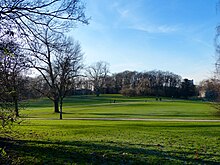Hiroshima Nagasaki Park
The Hiroshima-Nagasaki-Park was inaugurated on August 7, 2004 in part of the inner green belt in the Neustadt-Süd district of Cologne .
location
The park in the inner green belt is located between Aachener Straße , Universitätsstraße, Bachemer Straße and the railway area in the immediate vicinity of the Aachener Weiher and the Museum of East Asian Art . The relief of the green area in this area of the green belt is anthropogenic .
history
During the National Socialist era, this section of the Inner Green Belt was home to the so-called Maifeld , where the NSDAP's mass marches took place. Here there was also a terrace-like grandstand, which was crowned with a 15 × 20 m high imperial eagle . After the Second World War , rubble and rubble were piled up on the open spaces of the Maifeld in the area of what is now the park of the colloquial Mont Klamott or Aachener Berg . Originally, viewing platforms and viewing aisles were created on the mountain, but these no longer fulfill their function due to the higher tree vegetation.
On the initiative of the Cologne Peace Forum, it was suggested in 2000 that a park should commemorate the first atomic bombs on Hiroshima and Nagasaki . The then Mayor of Cologne, Fritz Schramma, initiated the search for a suitable parking area by the Cologne district representatives . At the end of 2001, the inner city district council unanimously decided to name the park area in the vicinity of the Aachener Weiher. The district council considered the choice of green space on a former mountain of rubble near the Museum of East Asian Art and the Japanese Cultural Institute to be the most suitable. Since 1985 Cologne has been a member of the Hiroshima-Nagasaki alliance, the international city alliance against nuclear weapons.
The park was inaugurated on August 7, 2004 by Mayor Renate Canisius in the presence of the Japanese consul Toshihiko Mochizuki and a survivor of the atomic bombing of Nagasaki , Kazuo Soda .
On August 5, 2007, the Abolish Nuclear Weapons Memorial was unveiled in the park , surrounded by three trees: a ginkgo for Hiroshima , a Japanese cherry for Nagasaki and a black poplar for Cologne. The memorial shows an origami crane, which refers to a Japanese legend , according to which anyone who folds 1000 origami cranes (sembazuru) receives a wish from the gods. After the death of the Japanese schoolgirl Sadako Sasaki , who after the atomic bomb was dropped on Hiroshima, she fought in vain against her radiation-induced leukemia by folding origami cranes , origami cranes have become a symbol of resistance against nuclear war and nuclear weapons worldwide.
![]()
Lajos Barta's 1966 sculpture, Ancient Form, was installed in the park in 1985 .
Sculpture Ancient Form by Lajos Barta
See also
Individual evidence
- ↑ Bruno Fischer: Cologne and the surrounding area 1933-1945: The historical travel guide . Chr. Links Verlag, Berlin 2012, ISBN 978-3-86153-692-5 , p. 39 .
- ^ René Zey: Parks in Cologne: A guide through the green spaces. Greven, Cologne 1993, ISBN 3-7743-0273-1 , p. 101 .
- ↑ Jeanette Seiffert: Cologne honors victims of the first atomic bombs. taz.de, April 7, 2004, accessed on January 18, 2016 .
- ↑ Hiroshima Nagasaki Park. Kölner Stadtanzeiger, August 9, 2004, accessed on January 18, 2016 .
- ^ Cologne Peace Forum : Hiroshima-Nagasaki Working Group. (No longer available online.) Archived from the original on March 28, 2016 ; accessed on January 18, 2016 . Info: The archive link was inserted automatically and has not yet been checked. Please check the original and archive link according to the instructions and then remove this notice.
Web links
Coordinates: 50 ° 55 ′ 59 " N , 6 ° 55 ′ 43" E







